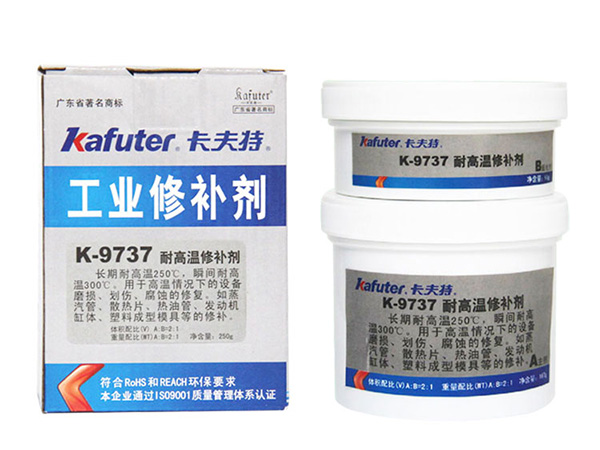Our life and environment can not be separated from high temperature glue. Many high temperature glue are behind the scenes services. Whether it is mobile phones, computers, tablets, cars, some drones, ships and other professional instruments, motors and electrical equipment, high temperature glue will be used. Here's Bunte to take a look...
Classification and use of high-temperature glue:
High temperature glue is a two-component industrial glue, high temperature glue is mainly used for structural adhesive and repair agent, repair agent is divided into high temperature repair agent and ultra high temperature repair agent. High temperature glue according to the material can be divided into: epoxy, copper oxide, silicate, silicon aluminate and so on. In addition to copper oxide is a high temperature structural adhesive, the high temperature adhesive of other materials is a repair agent.
Classification of high-temperature glue:
Ordinary epoxy glue can only withstand 80-120 degrees Celsius. The modified epoxy glue can reach 350-400 degrees Celsius for a short time and 200-300 degrees Celsius for a long time. Epoxy high temperature adhesive is a two-component, McLay, room temperature curing adhesive, filled with ceramic, metal and other polymerization, suitable for equipment wear, scratch, corrosion, broken parts repair under high temperature conditions, temperature resistance 320℃. Mainly used in high temperature conditions equipment wear, scratch, corrosion, broken parts repair, such as steam pipe, hot oil pipe, engine cylinder, paper dryer, plastic forming mold, etc. The commonly used models are 2737(HT737) high temperature repair and 2757(HT757) high temperature sealing repair.
High - temperature structural adhesive is two - component, copper oxide as the base material adhesive. Temperature resistance 980℃. Strong adhesion, high temperature resistance, easy to use, suitable for high temperature metal structure bonding and casting defects repair. Mainly used for bonding various carbide and ceramic turning tools, milling cutters, drills or gear cutters. The socket has high strength, which can be used to make lengthening rod and repair casting defects under high temperature conditions. The recommended model is Huitian 2712(HT812) high temperature structural adhesive.
Silicate high-temperature glue is generally made of alkali metal silicate as the main material, and some other curing agents, additives and fillers are added to the silicate. The adhesive properties and high temperature resistance of alkali metals of different categories are also different. The bonding strength of sodium salt is higher than that of potassium salt and lithium salt. Lithium salt has the best waterproof performance.
In the selection of curing agent, silicate high temperature glue generally use silicon oxide, magnesium oxide and so on. The selection of filler general selection: alumina, silicon carbide, boron carbide, mica and other fillers. The filler selected by high temperature glue itself must meet the mechanical strength, high temperature resistance, water resistance must be good.
Silicate high temperature resistant glue can withstand the highest temperature of 800 degrees -1200 degrees, the strength of bonding shear is generally 2-3MPa, used for high temperature resistant metal parts bonding and sealing, can also be used as wear-resistant, anti-oxidation coating. For example: metal, glass, stone, ceramic and some fireproof material bonding.
The ultra high temperature repair agent is a two-component, silicaluminate adhesive with temperature resistance of 1210℃. No insulation, heat conduction. Mainly used for heat conduction adhesive and wear resistant coating, high temperature resistant casting sag filling and repair. The cured material is ductile and processable. Suitable for stainless steel.
Use of high temperature glue:
1. Remove loose substances on the surface of the substrate, and polish by means of sandblasting, electric grinding wheel, wire brush or coarse sandpaper to improve the roughness of the repaired surface. Wipe with acetone cleaning agent to clean the surface.
2. The repair agent is composed of A and B two components. When used, the main agent A and curing agent B are fully mixed until the color is uniform and consistent in strict accordance with the prescribed mix ratio, and used up within the prescribed usable time.
3. Apply the mixed repair agent on the treated substrate surface with uniform application force and repeated press to ensure full contact between the material and the substrate surface to achieve the best results. When multi-layer coating is needed, the original coating surface should be treated before coating;
4. When the temperature is lower than 25℃, the curing time can be extended appropriately; when the temperature is lower than 15℃, the appropriate heat source (infrared ray, electric furnace, etc.) can be used for heating, but the repair part can not be directly contacted during heating. The correct operation should be that the heat source is more than 1000px away from the repair surface, and it should be kept at 60 ~ 80℃ for 2 ~ 3 hours.
Method to shorten curing time of high temperature glue:
1. Increase the ambient temperature.
2. Increase the temperature of the workpiece to be repaired.
3. After applying the repair agent, heat sources such as red lamp and iodine tungsten lamp are used for heating, but the heat source should be 400mm away from the repair layer (the ambient temperature should not be higher than 100℃), and the flame can not be used for direct heating.
High temperature resistant adhesive is a kind of high temperature resistant inorganic adhesive, good adhesion after curing, hard and non-cracking. What are the high temperature adhesive? We can have a comprehensive understanding from the classification of high temperature adhesive.
1. Classification of high temperature resistant adhesives according to the main chemical composition or base material
According to the main chemical composition of the adhesive or the base material, the adhesive can be divided into inorganic adhesive and organic adhesive two categories.
2. Classification by apparent physical form
According to the appearance of adhesives on the market, adhesives are often divided into the following four types.
(1) Solvent type. Synthetic resin or rubber in the appropriate solvent with a certain viscosity of the solution, all synthetic resins are mainly thermosetting and thermoplastic type two types, so the rubber includes natural rubber and synthetic rubber.
(2) emulsion type. Synthetic resins and rubber are dispersed in water to form aqueous solutions and emulsions
(3) Paste or paste type. This is a kind of synthetic resin and rubber mixed into volatile high viscosity adhesive, mainly used for sealing and caulking.
(4) solid type. Generally, thermoplastic synthetic resin or rubber is made into granular, block or strip, after heating and melting can be coated, after cooling that is curing, also known as hot melt film type. The adhesive coated in a variety of substrates (paper, cloth, glass, etc.), film tape, or directly made of synthetic resin or rubber film use, the latter often has higher adhesive strength occasions.
3. Classification by curing mode
Adhesives in the bonding process are generally required to cure, according to the curing way is generally divided into the following five kinds.
(1) water-based evaporation type. Such as polyvinyl alcohol aqueous solution and vinyl - ethyl acetate copolymerization emulsion adhesive.
(2) solvent volatile type. Such as neoprene adhesive.
(3) hot melt type. Such as granular, stick, strip - ethyl acetate hot melt adhesive.
(4) chemical reaction type. Such as a- cyanoacrylate instant glue, acrylic double - fat anaerobic glue and butyl rubber.
(5) pressure sensitive type. Pressure can be bonded and not curing adhesive, commonly known as self-adhesive.
4. Classification by force
Generally, adhesives can be divided into two categories: structural adhesives and non-structural adhesives.
(1) structural adhesive. This type of adhesive can transfer large stress, can be used to bond structural parts. This adhesive is usually made of thermosetting resin, commonly used epoxy resin or modified epoxy resin, phenolic resin or modified phenolic resin as the main components.
(2) non-structural adhesive. This kind of adhesive can not transfer large stress, often used in hot melt resin, synthetic rubber as the main component, such as used in the electronics industry of silicone rubber adhesive.
5. Classification by use
According to the use of adhesive classification mainly metal, plastic, fabric, paper products, medical, shoes, woodworking, construction, automobile, aircraft, electronic components and other adhesive, as well as special functional adhesive, such as conductive adhesive, magnetic adhesive, high temperature resistant glue, conductor glue, medical glue.

